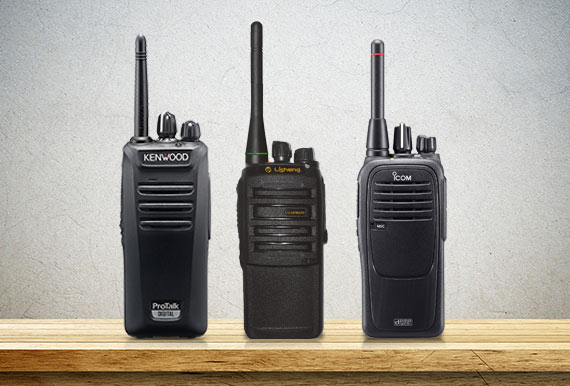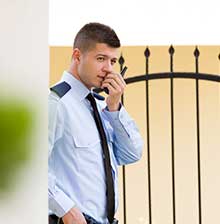Schools / Campus
From maintaining the grounds to keeping staff secure dPMR 446 can work to keep the site at its best. Radio systems can also be used for sports and field trips.
dPMR 446 is a licence-free two-way radio communication format for use in peer-to-peer operations without base stations or repeaters in the 446 MHz UHF band. This technology is covered by the ETSI standard TS102 490.
dPMR 446 is a digital format of PMR446 (Personal Mobile Radio 446), a European licence-exempt two-way radio system which was introduced in analogue (FM) format in 1998 followed by digital (FDMA & TDMA) in 2005.
dPMR 446 provides a simple and cost-effective basis for instant communication between users over distances of up to 6km (although actual PMR446 coverage and range depends on terrain and the environment) with both transmission and reception taking place on the same channel.
dPMR446 equipment is capable of both voice and data modes of operation using a simplified addressing system that can be considered analogous with CTCSS use in PMR446 or with an extended addressing system as used by the fully functional TS102 658 type dPMR radios.
As well as offering voice and data capabilities, the dPMR446 protocol also supports combined voice+data so it is possible to embed data into a voice call or automatically append it at the end of a call.
This means that dPMR446 can offer all the usual voice services plus text messaging (SMS), status information texts, embedded data such as GPS position etc.
A further benefit of dPMR equipment is that they can operate in both analogue (FM) and digital (dPMR 446) modes which allows users to migrate from an existing analogue fleet to the benefits of digital dPMR
446 without having to replace all their radios at the same time.
All equipment for use on PMR446 frequencies, whether analogue or digital, is required to be in hand portable form, feature a fixed integral antenna and operate with an effective radiated power not exceeding 500mW (0.5 watts), while the use of base station, mobile radio, repeater or fixed infrastructure is specifically excluded.

PMR446 compliant equipment may be used in the following CEPT (European Conference of Postal and Telecommunications Administrations) territories and their overseas or semi-autonomous territories without restriction:
| Austria | France | Luxembourg | Russian Federation |
| Belgium | Germany | FYRO Macedonia | Slovenia |
| Bosnia & Herzegovina | Greece | Moldova | Spain |
| Bulgaria | Hungary | Monaco | Serbia |
| Croatia | Iceland | Montenegro | Slovak Republic |
| Cyprus | Ireland | Netherlands | Sweden |
| Czech Republic | Italy | Norway | Switzerland |
| Denmark | Latvia | Poland | Turkey |
| Estonia | Liechtenstein | Portugal | Ukraine |
| Finland | Lithuania | Romania | United Kingdom |
- Includes the overseas or semi-autonomous territories of Denmark, France, Greece, Italy, Netherlands, Norway, Portugal, Russian Federation, Spain plus the constituent parts of the United Kingdom as well as the Channel Islands and the Isle of Man.
- Assignments for use of licence free radios may change from time to time and the user is advised to check if PMR446 equipment can be used in the destination country.
Digital PMR 446 v Analogue PMR 446
dPMR is an FDMA (Frequency Division Multiple Access) channel access method offering true spectrum efficient 6.25kHz channel spacing while DMR 446 is a TDMA (Time division multiple access) channel access method with 12.5kHz channel spacing. In practical terms, as dPMR 446 provides 16 digital channels against the 8 digital channels DMR 446 offers, users are better able to avoid channel congestion and restrictions of service availability especially in cities or at times of peak demand.
At the time of writing, the frequency band 446.1-446.2 MHz has been designated for use by digital PMR 446 equipment, however to ensure continued availability of license-exempt analogue and digital PMR446 frequency bands and reduce congestion, new PMR 446 frequencies are being introduced across Europe from 1 January 2018 in line with Harmonised European Standards EN 300 296-2, EN 300 113-2 and EN 301 166-2. The new frequencies, which follow ECC Decision (15)05, create greater capacity by extending the assigned frequency spectrum for digital equipment to 446.0 - 446.2 MHz with a channel plan based on 6.25 kHz and 12.5 kHz spacing where the lowest carrier frequencies are 446.003125 MHz and 446.00625 MHz respectively.

Equipment tested and certified as complying with dPMR Mode 1 of the ETSI standard TS102 658 is available from members of the dPMR Assciation including Icom, Kenwood and Lisheng, details can be found in the Product Showcase pages or the manufacturer’s websites. Please be aware that equipment offered by other manufacturers employing low quality vocoders and chipsets which have not been tested or certified as complying with the applicable ETSI standard may not offer the full range of functions or be interoperable with compliant equipment. If in doubt, please contact secretary@dpmr-mou.org for clarification.

From maintaining the grounds to keeping staff secure dPMR 446 can work to keep the site at its best. Radio systems can also be used for sports and field trips.

Working from goods inwards, through refrigeration to front of house dPMR 446 can keep service at its best for restaurants and smaller hotels.

dPMR 446 can work with you on site helping you to stay in touch with your immediate team on local construction across smaller sites.

From goods in to the warehouse, through process control and quality testing dPMR 446 can let you drive productivity to the highest possible level.

To connect teams deployed in shops, town centres and more dPMR 446 can be the on the ground advantage that your business needs.

For everything from security through to sales, dPMR 446 is how to bring it all together, especially in larger retail spaces e.g. builder’s merchants.
Membership info or technical data and all else in between; we're happy to answer your queries ...
The dPMR Association was established in 2007 and provides a forum for interested parties to contribute their expertise.
Get the latest updates